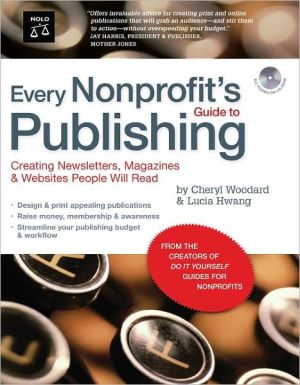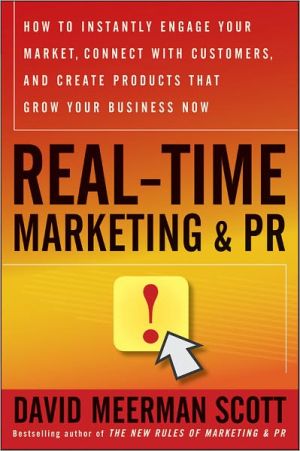Every Nonprofit's Guide to Publishing: Creating Newsletters, Magazines & Websites People Will Read
Everything you need to raise awareness, membership and money!\ \ Nonprofits have certain advantages passion, motivation, a sense of purpose. But to raise the money and support required to achieve your goals you need to communicate your mission effectively.\ \ You can do it -- let Every Nonprofit's Guide to Publishing show you how!\ \ Practical and hands on, this book shows you how to overcome inexperience and budget constraints -- and produce publications that effectively promote your cause....
Search in google:
Everything you need to raise awareness, membership and money!Nonprofits have certain advantages passion, motivation, a sense of purpose. But to raise the money and support required to achieve your goals you need to communicate your mission effectively.You can do it -- let Every Nonprofit's Guide to Publishing show you how!Practical and hands on, this book shows you how to overcome inexperience and budget constraints -- and produce publications that effectively promote your cause. From developing an idea to distributing the final publication, you'll get the information youneed. Find out how to:design and print engaging magazines or newsletterscreate an appealing websitelocate the best freelancers and vendorsdevelop successful ad sales and fundraising strategiesmeet IRS and postal requirements for nonprofitsuse time-tested publishing ideas and resourcesThe book includes practical suggestions from veteran insiders, whose experiences range from tiny nonprofit startups to large, established organizations. The CD-ROM provides essential forms, checklists, schedules, worksheets, spreadsheets and more. Timothy Lyster - The Nonprofit Quarterly This comprehensive guide covers -- in an informative and lively way -- everything you'll need to manage your publication from concept to finished product.
Introduction\ Every publication serves two masters: the organization that pays the publishing bills and the people who read it. This chapter will help you create a publication that meets both of their needs.\ First, it reviews the most common reasons nonprofit organizations launch newsletters, magazines, and online publications. Next, it discusses your publication's purpose, focusing entirely on how it will meet your organization's needs. It then explains how to meet your readers' needs through establishing the publication's editorial mission. It offers practical\ advice about how to balance the interests of your nonprofit and the publication's readers -- and ends with some tips for troubleshooting common problems.\ Balancing Priorities\ While it may seem easy to define a publication's purpose and mission, expect some disagreement -- especially if the publishing venture is new or represents a change from the way things have been done in the past. Publications often generate new and unexpected confusion within a nonprofit or churn up longstanding controversies within it.\ Often, no one on staff has any editing or publishing experience, but everybody has ideas about what should be published in the new newsletter, magazine, or website. Some ideas will be wonderful. And some will be completely inappropriate -- such as the one from the board member who wants to put his grandson's video project on your alumni association website. Or the major donor who wants to advertise her Hummer dealership in your ecology club newsletter.\ Money can be another source of confusion and dissension. Program managers may resent the money earmarked for a flashy website ratherthan for their programs, and board members may have unreasonable hopes about generating donations or ad revenues with a new magazine.\ And, not knowing any better, everyone may expect to create a first-class product on a third-class budget, with no extra staff and no extra time allowed for planning sensibly.\ You will never completely avoid conflict, but you can reduce much of it by taking the time to thoroughly discuss and define both a purpose and an editorial mission for every new magazine, newsletter, or online publication. (See "Crafting Your Mission Statement," below, for details about communicating ideas within the organization.) This step will help\ manage everyone's expectations, and also help fend off inappropriate suggestions down the road, by developing and communicating your plans before the publishing begins. And if you are reevaluating an established publication -- looking for a new direction or greater impact -- then writing the purpose and mission statements anew can lead to fresh ideas and help resolve dissension. (See "Troubleshooting Editorial Mission Problems," below, for more about revamping a conflicted publishing project.)\ The Publication's Purpose\ The first essential task is to decide what purpose a publication will serve for its organizational master, your nonprofit, and how it will contribute to those goals. Think in terms of outcomes that you hope will result after making the effort to publish: more donations, happier volunteers, greater success in your efforts to educate or empower people. The road to successful publishing starts with a clear sense of where you want to go and why.\ Often, the purpose of a nonprofit's publication is obvious and unequivocal: The board of directors wants to attract younger members by sending out an email newsletter, for example, or the organization's new director who has venture capital roots hopes to attract big donors through a slick magazine. But sometimes the purpose is less clear -- and in those situations, it is wise to gather input from a group of those involved to get a consensus before going forward. (See "Crafting Your Mission Statement," below, for details.)\ There are a number of reasons nonprofit organizations typically decide to publish a magazine, newsletter, or website -- ranging from getting new members to targeting underserved ones. Often, a publication serves a number of purposes.\ Recruiting and Retaining Members\ Publications can be extremely effective in recruiting and retaining members for consumer associations, arts organizations, and hobby or professional groups. Skimming through nonprofit member publications, you will usually find membership issues highlighted through photographs of\ organization activities, articles promoting the benefits of belonging, and information about how to participate. In addition, by providing useful information about the nonprofit's cherished causes, such publications can become prized benefits on their own. In fact, organizations commonly list their print publications, electronic newsletters, and members-only Web features as primary membership benefits.\ While the technique is not generally available for newsletters or not relevant for online publications, some nonprofits use their magazines to recruit members by distributing them widely on newsstands and in bookstores.\ Example: The National Audubon Society produces a lavish, award-winning magazine, Audubon, to inspire new readers to join one of the 500 local chapters of the Society and help protect wildlife. Published bimonthly, the magazine is a public expression of the group's mission and activities. Every issue is filled with inspiring nature photographs, articles about how to participate in the Society's work around the world, and thoughtful \ information about environmental issues.\ Not every member publication needs to be lavishly produced to attract the attention of potential members. It is most important for the publication to reflect the mission and voice of your organization.\ Example: The magazine Coop America Quarterly has a humble, down-to-business appearance befitting the organization's mission, which is harnessing economic power to create a socially just and environmentally sustainable society. The publication's editors convey the value of belonging to the organization by packing each 40 practical advice on sustainable living and responsible investing. People looking for an alternative to the high-consumption values they find in other magazines are attracted to the low-impact values expressed in the Quarterly, and the magazine draws in lots of new members at "green living" conventions and other venues where it is displayed.\ \ Creating a Sense of Community\ Some people are compelled to join a particular nonprofit organization because they crave a connection to people with whom they work or live. This is true for some unions and rural cooperatives that exist because of a shared type of work or location.\ In addition to making new people feel welcome, these organizations can use their publications to remind existing members how they benefit from belonging to the organization and encourage them to remain involved.\ Example: Kentucky Living is a monthly magazine that reaches 500,000 members of the state's rural electric cooperatives. It is distributed exclusively to people who already belong to a cooperative, and there is no attempt to use the magazine to recruit outside readers or new members. Instead, the magazine's sole purpose is to "create a community of people who take pride in thinking of themselves as Kentuckians and as knowledgeable electric coop members to improve their quality of life." The design is humble to deliberately send members a message that their money is not being used for lavish publication expenses -- and the content is helpful rather than confrontational. The editors steer clear of divisive politics, for example, and focus instead on profiles of local people and articles about energy efficiency. Ads are welcomed, particularly from local companies and coop members.\ \ Educating About Issues\ Many nonprofit publications are designed to "change the world" by arming individuals with information that empowers them to make thoughtful choices. The newsstands are filled with examples in the fields of environmental protection, health care, public affairs, culture, and social justice.\ The goal of these publications is to reach as many like-minded people as possible and provide readers with unique and compelling information about the nonprofit's cause. To reach the widest possible audience, organizations with a cause to promote often decide to publish in several formats at once: websites, blogs, podcasts, electronic newsletters, and print publications. And every publishing effort is designed to reflect the mission and the expectations of the audience -- using environmentally friendly soy inks for an ecology magazine, for example, or online audio clips and blogs for one about political issues.\ Example: Mother Jones magazine publishes revelatory journalism that \ seeks to "inform and inspire a more just and democratic world." Designed to reach the widest possible audience, the magazine is distributed in bookstores and to about 200,000 paid subscribers. Each bimonthly issue averages 90 pages in print with additional material simultaneously published online. The magazine is also available on microfilm, on CD-ROM, and electronically, and the organization also recently launched a radio program, podcasts, and blogs. When the editors take up an issue such as global warming or campaign finance reform, they are also able to engage readers in a two-way conversation through online forums.\ But a big-scale approach to news may not be reasonable for every cause-related publication. Many smaller nonprofits choose to focus on communicating in depth with a smaller number of people -- a strategy that does not require many resources. Nonprofits can have tremendous impact by concentrating on a small, tightly defined audience and then providing wonderful journalism packaged in much humbler clothing.\ Example: The Ecology Center of Berkeley, California, publishes Terrain magazine four times per year. Its mission is to educate and inform a dedicated community of environmental activists living in the San Francisco area -- people who have been working on environmental issues for many years. To save costs, each issue is limited to 40 pages produced on the least expensive paper, with minimal use of color and other expensive design elements. Instead of spending money on fancy packaging or technology, the Terrain editors focus the nonprofit's small budget on acquiring great reporting from a large stable of talented local writers.\ \ Activating Readers\ Having assembled an audience of like-minded people, many organizations use a publication to call them into action on specific issues. Through a newsletter, a magazine, a website, or emails, readers can be recruited to write letters, sign petitions, donate money, vote, volunteer, or attend conferences. The editorial style of these communications is focused and specific -- telling targeted individuals what they're being asked to do and why and providing an easy way to respond.\ Example: By covering political and education issues in its main newsletter, \ California Teacher, the California Federation of Teachers tries to motivate its readership to advocate for the teaching profession, whether it's for more respect, better funding, or defeating political measures seen as damaging to students and teachers. The newsletter is one of the union's main methods for communicating with and activating its 120,000 members. For example, its articles explain why the organization endorses candidates and ballot measures. It has asked readers to donate money to causes to help teacher colleagues in other parts of the country. And it encourages readers to attend upcoming conferences and meetings of the organization's leadership by listing a calendar of events in every issue.\ Lobbying restrictions. Some 501(c) nonprofits either cannot take any stances on political initiatives or offices or must severely limit their spending on political activities. Unions and some other organizations are given special leeway, but many nonprofits are legally restricted in lobbying. Be sure you know the rules for your organization before you start publishing. (See Chapter 5, "Lobbying Restrictions May Limit Your Content," for more details.)\ Boosting Contributions\ Often, the best future contributors to an organization are the people who have made a donation in the past. Recognizing this, many nonprofits publish newsletters or magazines just for their donors and volunteers, or have sections or entire websites that only people fitting\ these categories can access.\ These publications focus on communicating the work the organization is doing for an important cause and highlight why that work is important. Sometimes citing academic experts, independent journalists, or government officials, these publications often take pains to educate readers about the overall state of the problem and the remedies their nonprofit is developing. Such publications are often filled with appeals for additional support and photographs of the people who benefit from it. It's also a common practice to profile and praise volunteers so that other people are inspired to do the same.\ Example: World Ark magazine is a donor publication published by the Heifer Project, a group that strives to end world hunger through sustainable agriculture programs. Anyone who gives $25 to Heifer automatically receives a year's subscription to World Ark. Each issue profiles successful Heifer projects and explains the organization's different programs around the world. Photographs show the faces of people Heifer is helping and the Heifer volunteers who are helping them. The magazine puts Heifer's work in \ context by running excerpts from popular books, for example, or statistical information about poverty -- so that readers also learn something. The magazine has been so successful at raising new donations from past contributors that Heifer recently was able to increase its frequency from four to six issues per year and the number of pages in every issue from 36 to 48.
1. Getting StartedBalancing PrioritiesThe Publication's PurposeThe Publication's Editorial MissionCrafting Your Mission StatementTroubleshooting Editorial Mission Problems2. Managing the Publishing ProcessAn Overview of the Publishing ProcessManaging the ProcessCreating Calendars and SchedulesEnforcing Deadlines3. Making a BudgetConsulting With Accounting AdvisersUsing Accounting SoftwareEstablishing a Chart of AccountsBudgeting Tips for PublicationsUsing Budgets to Prove PerformanceIRS Reporting RequirementsPostal Service RequirementsCreating a Publishing BudgetVariable Expenses4. Finding and Hiring HelpCommon Tasks and StaffingEstablishing an Editorial Advisory BoardDetermining Staffing NeedsWhat to Do When Short-HandedHiring New StaffHiring FreelancersWhat to Include in a Freelance ContractManaging Freelance Arrangements5. Creating Compelling ContentDeveloping Story IdeasChoosing the Right TreatmentTurning Ideas Into WordsWriting for the Web6. Designing Print Publications and WebsitesThe Function of DesignYour Publication's DesignCreating a Design GridCreating a MapObtaining ArtworkTips for Saving Money on DesignConducting Quality Control7. Printing Newsletters and MagazinesFinding a PrinterAvoiding MistakesA Look at the Mechanics of PrintingGetting Distribution Help From PrintersChoosing PaperUsing ColorAdditional Printing ChargesNegotiating a Printing ContractTroubleshooting the Printer Relationship8. Producing a WebsiteStrengths of theWebWeb Programming ToolsMaking the Most of Search EnginesWebsite Planning TipsOptions for Building Your WebsiteTesting Your Website9. Distributing and Promoting Your PublicationAcquiring ReadersPricing Your PublicationTesting Your MarketChoosing the Best Promotion StrategiesTracking Readers Through a Database ProgramMailing Through the US Postal ServiceDistributing Emails10. Selling AdvertisingDeciding Whether to Sell AdsTax ConcernsPostal RegulationsEthical Standards for AdvertisingManaging the Ad Sales ProcessOther Revenue OpportunitiesCompleting Your Advertising Plan11. Connecting to ReadersProfiling Your ReadersGauging Reader InterestIs Your Publication Fulfilling Its Purpose?Creating Surveys and Other Feedback ToolsUsing Performance BenchmarksUsing Feedback to Win Support12. ResourcesAccountingCopyrightsDesigningGovernment AgenciesHiring Artists, Writers, and DesignersNonprofits, GenerallyPrintingPublishing Courses and SeminarsPublishing, GenerallySurveys and Other FeedbackWebsite ConstructionWriting and EditingAppendix: How to Use the CD-ROMIndex
\ ForeWard MagazineDiscusses how organizations can overcome budget constraints and inexperience to produce products that will promote their cause...\ \ \ \ \ Mother Jones magazineDo not lift a finger to start a nonprofit publishing venture before reading every page of this book.\ — Mark Dowie\ \ \ Mother JonesOffers invaluable advice for creating print and online publications that will grab an audience -- and stir them to action -- without overspending your budget.\ — Jay Harris\ \ \ \ \ National GeographicThe authors understand what it's like to work with little money and too much to do. It is great for training others or for answering your own questions...\ — John Griffin\ \ \ \ \ Stanford Publishing CoursesA practical, example-filled resource from two publishing experts who've been there, done that. This kind of experience-based advice is priceless...\ — Holly Brady\ \ \ \ \ The Nonprofit QuarterlyThis comprehensive guide covers -- in an informative and lively way -- everything you'll need to manage your publication from concept to finished product.\ — Timothy Lyster\ \








